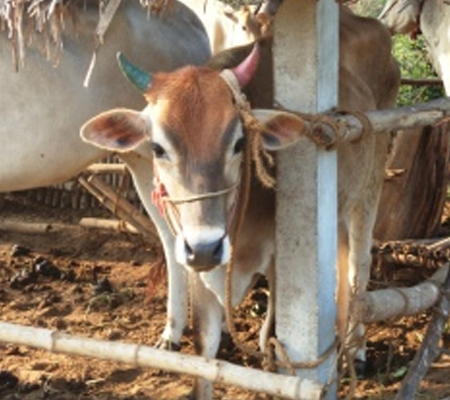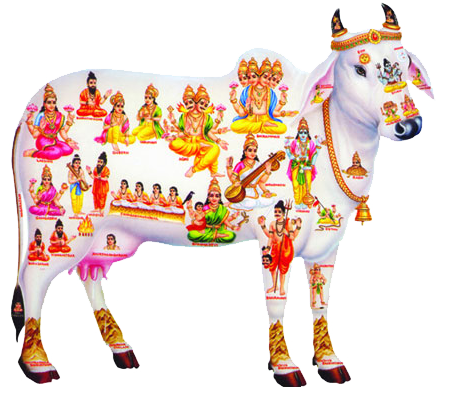Cow & Hindu mythology
 Kamadhenu, the sacred cow which grants all wishes and desires, is an integral part of the Hindu mythology. This divine cow, which lives in swargalok (heaven), emerged from the ocean of milk (ksheerasagar) at the time of samudramanthan (the great churning of the ocean by the gods (suras) and demons (asuras). It was presented to the seven sages by the Gods, and in course of time came into the possession of Sage Vasishta.
Kamadhenu, the sacred cow which grants all wishes and desires, is an integral part of the Hindu mythology. This divine cow, which lives in swargalok (heaven), emerged from the ocean of milk (ksheerasagar) at the time of samudramanthan (the great churning of the ocean by the gods (suras) and demons (asuras). It was presented to the seven sages by the Gods, and in course of time came into the possession of Sage Vasishta.
Kamadhenu's complexion is like the white clouds. Every part of cow's body has a religious significance. Its four legs symbolize the four Vedas, and its teats the four Purusharthas (i.e. four objects or aims of human existence. These are (i) dharma or righteous conduct, (ii) artha or wealth, (iii) kama or desire, and (iv) moksha or liberation. Its horns symbolize the holy trinity of Hindu gods (Brahma (tip), Vishnu (middle) and Shiva (base)); her eyes are the Sun and Moon gods, her shoulders represent the fire-god Agni and the wind-god Vayu.
Actually all gods are believed to reside in the body of Kamadhenu — the divine cow. The image here illustrates the vedic teaching that each part of the cow embodies a particular deity. Kamadhenu is also well-known through its other five forms: Nanda, Sunanda, Surabhi, Susheela and Sumana.
In Srimad Bhagavatam, Lord Krishna says "…..I can be worshiped within cows by offerings of grass and other suitable grains and paraphernalia for the pleasure and health of the cows.
The cow symbolizes the dharma itself. Mythologically, Brahma (the creator) created the brahmins (priests) and the cow at the same time, the Brahmins were to recite the religious scriptures while the cow was to afford ghee (clarified butter) for offerings in religious sacrifices. Brahma also affirmed cow to be the mother of gods, which ought to be worshipped.  Anybody who killed a cow or allows another to kill it, was deemed to rot in hell, for as many years as there are hair upon his body.
Anybody who killed a cow or allows another to kill it, was deemed to rot in hell, for as many years as there are hair upon his body.
Some temples and houses have images of Kamadhenu, which are worshipped. The cow does not have any temples where she is worshipped as the chief deity, but it is regularly fed outside temples and worshipped regularly. In many households, a portion from the regular daily first meal is set aside to be fed to the cow. To a pious Hindu, every cow is regarded as an Avataar (earthly embodiment) of the divine Kamadhenu.
NO COW, CALF OR BULL, which enters the Goshala, IS EVER SOLD OR DONATED.
Goseva means serving the cows.
Bhagavat Geeta describes how Lord Krishna cared for the cows and calves every morning, by taking them to graze on the Govardhana hill. We should also try to serve the cows with similar attitude – by providing means for their food, shelter and medication.
Our mission is to care for stray, abandoned cows, bulls, retired oxen, and orphaned calves. We provide them with hay, flour, fresh grass, clean water, medical attention and a sheltered place where they can recuperate from injuries and stay peacefully, in good social company.
At present we host a herd of over 1,600 cattle. But there are thousands of cattle requiring attention and unless protected, they are destined to subsist on refuse and become plagued by various debilitating and often terminal diseases, suffer injury from careless motorists, or worse,